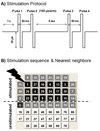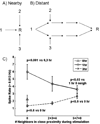Chronic electrical stimulation of cultured hippocampal networks increases spontaneous spike rates
- PMID: 19666055
- PMCID: PMC2753692
- DOI: 10.1016/j.jneumeth.2009.07.031
Chronic electrical stimulation of cultured hippocampal networks increases spontaneous spike rates
Abstract
We chronically stimulated hippocampal networks in culture for either 0, 1 or 3h/day between 7 and 22 days in culture in an effort to increase spontaneous spike rates and to give these networks some portion of external stimuli that brain networks receive during their formation. Chronic electrical stimulation of hippocampal networks on multi-electrode arrays (MEAs) increased spike rates 2-fold after 3 weeks of culture compared to cultures that received no external stimulation prior to recording. More than 90% of the spikes for all experimental conditions occurred within bursts. The frequency of spikes within a burst increased with time of stimulation during culture up to 2-fold higher (90Hz) compared to networks without chronic stimulation. However, spontaneous overall spike rates did not correlate well with the amount of stimulation either as h/day or proximity to the limited number of stimulation sites due to shorter burst duration with 3h/day stimulation. The results suggest that chronic stimulation applied during network development recruits activity at 50% more electrodes and enables higher rates of spontaneous activity within bursts in cultured hippocampal networks.
Figures





References
-
- Chang JC, Brewer GJ, Wheeler BC. Neuronal network structuring induces greater neuronal activity through enhanced astroglial development. J. Neural Eng. 2006;3:217–226. - PubMed
-
- Chiappalone M, Novellino A, Vajda I, Vato A, Martinoia S, van Pelt J. Burst detection algorithms for the analysis of spatio-temporal patterns in cortical networks of neurons. Neurocomputing. 2005;65–66:653–662.
Publication types
MeSH terms
Grants and funding
LinkOut - more resources
Full Text Sources

